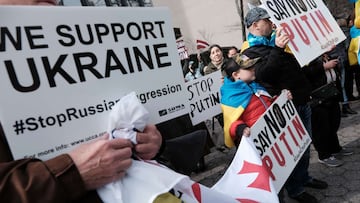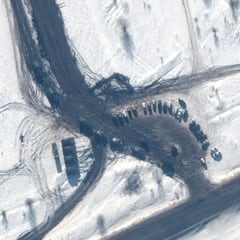What is a false flag operation?
As the world's attention is drawn to Ukraine, many in the media are talking about the possibility of a Russian provoking an situation that they can use as a pretext for invasion. What is a false flag operation?


A false flag operation, in relation to war and violent conflicts, refers to situation wherein one group commits an act which aims to avoid being blamed or shift blame to another party to justify an attack of invasion.
For weeks, the United States has been stating publicly that Russia might be planning a false flag operation to create a pretext to invade Ukraine. During Secretary of State Anthony Bliken's speech in front of the United Nations Security Council on 17 February he said that "Russia plans to manufacture a pretext for its attack."
He warned leaders that this pretext could come in various forms including the possibility of a "fabricated so-called “terrorist” bombing inside Russia, the invented discovery of a mass grave, a staged drone strike against civilians, or a fake – even a real – attack using chemical weapons."
Kyiv and Moscow blamed each other for clashes in Ukraine’s Donbas region, which the US believes is a ‘false-flag’ operation for Russia to invade Ukraine within the next few days https://t.co/ldFKjvzAFk
— Financial Times (@FinancialTimes) February 17, 2022
The United States began seriously warning the world of a possible false flag operation by Russia in early February.
"First of all, you know, we've discussed this idea of false flags by the Russians before. We've made no secret of that, and we do have information that it is -- that -- that -- that the Russians are likely to want to fabricate a pretext for an invasion, which again, is right out of their playbook, said John F. Kirby, a spokesmen of the Department of Defense.
On the same day, Ned Price a senior official at the US State Department hosted a press conference providing a similar message and received push back from a journalists.
After delivering his opening remarks, Price was asked if his statements made based on declassified evidence would be released so the press could confirm it. Price responded saying "We told you a few weeks ago that we have information indicating Russia also has already pre-positioned a group of operatives to conduct a false flag operation in eastern Ukraine. So that, Matt, to your question, is an action that Russia has already taken."
Matt Lee, a reporter for the Associated Press, pushed back saying "No, it’s an action that you say that they have taken, but you have shown no evidence to confirm that."
Price defended the move to tell the press about the possibility of a Russian false flag for deterrence. However Lee continued his questing, asking if Price expected the press "to believe [the intelligence] without" the government "showing a shred of evidence that it’s actually true." Lee argued that just because Price made the statement, did not constitute the sharing of evidence. Price went on to attack Lee for questioning the reliability of US government and British sources, which felt like an overreaction. Lee mentioned that government's passed failures when it came to the sharing of intelligence --WMDs in Iraq, the assurances that Kabul would not fall to the Taliban --questioning the methods by which the department informs the media, and the public, about intelligence they have obtained.
When did the 'false flag' term originate?
Historians trace use of the term back to the sixteenth century. Grammarphobia, a writing support site, noted that when it originally surfaced it was typically refereed to as a "figurative expression." Around three-hundred years later the term earned a literal meaning as well, when pirates and privateers would use the lour of a friendly flag as a pretext to take over an unsuspecting ship.
In more recent years, the term has been used to refer to instances where a government will provoke an event which often allows for greater domestic repression or an international response, typically violent in nature.
United States and the sinking of the USS Maine
The United States has never confirmed or admitted to executing on a false flag operation to get involved in a military conflict. However, the sinking of the USS Maine, an event leading up to the Spanish-American War helps to explain danger of these events.
With tensions growing in Cuba, still a colony of Spain in 1898, the United States moved a Navy ship, the USS Maine, to the Port of Havana.
On 15 February the ship suffered an explosion and to date the exact details of the explosion, specifically if it originated inside the ship or was the result of a Spanish torpedo is unknown.
Related stories
Many believe that this event led to the immediate declaration of war against Spain, however, this is not the case. The United States blamed Spain, but official declarations would not be made for two months. During that time, the Spanish conducted an investigation and reported that the ship sank after an explosion in the coal bunker, not from a weapon of theirs.
The US Navy conducted their own investigation and determined that the ship sank after being hit by a torpedo. While a declaration of war was not made within the days of the event, it did help galvanize support for the war. Whether or not the US really knew if Spain was responsible, the point served as an turning point towards war. Later investigations have been inconclusive or claimed that the coal bunker theory is more plausible. Regardless, the example shows that when tensions are high, even an accident or fluke can have fatal consequences.

